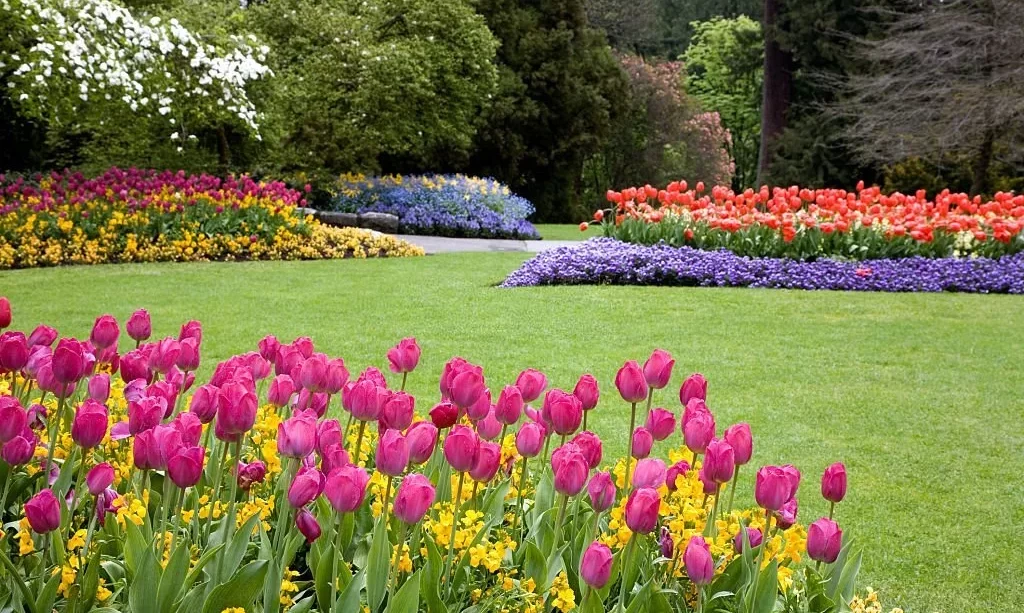Tulips, with their vibrant and captivating blooms, are a sure sign that spring has arrived. These flowers, known for their incredible variety of colors and shapes, have long been a favorite among gardeners and flower enthusiasts alike.
As spring approaches, the anticipation of tulip blossoms gracing gardens and landscapes fills the air. Yet, a question often lingers in the minds of tulip admirers: Do tulips bloom more than once? In this article, we embark on a journey to unlock the mystery of tulip flowering. We’ll delve into the intricate world of tulip growth and the factors that determine their blooming behavior.
Whether you’re an experienced gardener or simply curious about these iconic spring blooms, join us as we uncover the secrets behind tulip blossoms and explore whether they have the potential to grace us with their beauty more than once a year.
- Multi Colors in spring
- EASY & SIMPLE
- Plant now and enjoy in spring
- Nothing special to do
- colorful display of tulips in spring
Tulip Growth and Blooming
To unravel the enigma of tulip reblooming, it’s essential to begin by understanding the typical growth and blooming patterns of these beloved flowers. Tulips, like many other bulbous plants, undergo distinct stages in their life cycle. These stages play a crucial role in determining when and how tulips display their stunning blossoms. Let’s take a closer look at these growth phases and the natural progression that leads to the breathtaking spring displays we associate with tulips.
Tulip Varieties: A Matter of Blooming Behavior
The world of tulips is incredibly diverse, with thousands of cultivated varieties to choose from. What makes tulips even more intriguing is that their blooming behavior can vary significantly based on their variety. In this paragraph, we’ll explore how the choice of tulip variety can determine their flowering habits:
- Early, Mid, and Late-season Tulips: Tulip varieties are categorized into three primary groups based on their blooming times: early, mid, and late-season tulips.
- Early Tulips: These varieties burst into bloom in the early weeks of spring, often among the first flowers to grace gardens. They create a spectacular start to the season.
- Mid-season Tulips: These tulips follow the early bloomers, filling gardens with color in the mid-spring period.
- Late-season Tulips: Late-season varieties offer a grand finale to the tulip show, extending the display well into late spring.
- Reblooming Varieties: Some tulip varieties are more likely to rebloom than others. These are often referred to as “perennial” tulips and have a higher chance of flowering for multiple years.
- 100% organic and natural hand crafted blend
- Includes a target pH of 6.5
- Available in a 4 pound size
- 100 percent natural and organic
- Bigger, more abundant blooms naturally
Can Tulips Bloom More Than Once?
The burning question of whether tulips can bloom more than once hinges on the typical behavior of most tulip varieties. Here, we address the heart of the matter:
- One-time Bloomers: The majority of tulip varieties are considered one-time bloomers. They put on their dazzling display in the spring, and the blooms are often short-lived, lasting for a couple of weeks.
- Annual Approach: For these tulips, the bulbs typically exhaust their energy during the initial bloom, making it challenging for them to rebloom the following year.
- Exceptions and Strategies: While most tulips are one-time wonders, there are exceptions. Species tulips, certain wild varieties, and some perennial tulips are more likely to rebloom. Additionally, specific care strategies can be employed to increase the chances of tulip reblooming.
Understanding the range of tulip varieties and their blooming behaviors allows gardeners to make informed choices when selecting and caring for these delightful spring flowers. While the majority of tulips are cherished for their ephemeral beauty, the potential for reblooming adds an exciting dimension to the world of tulip cultivation.
Exceptions to the Rule
While most tulips adhere to the one-time blooming rule, there are exceptions that defy this norm. In this section, we explore these exceptional tulips and the unique characteristics that set them apart:
- Species Tulips: Certain species tulips, often derived from wild tulip varieties, exhibit a more perennial nature. They are known for their ability to naturalize and rebloom reliably year after year.
- Wild Varieties: Some wild tulip varieties have evolved to adapt to specific climates and conditions, enabling them to rebloom with greater consistency.
- Perennial Tulips: Certain perennial tulip hybrids have been bred to have a higher likelihood of reblooming. These varieties are sought after by gardeners looking to enjoy tulip displays in subsequent years.
- FOR USE ON: Use Bulb-tone organic fertilizer for all Fall bulbs like tulips, daffodils, crocus & hyacinths and on Spring bulbs like gladioli and lilies
- CONTAINS: Bulb-tone is a rich blend of the finest natural & organic ingredients enhanced with our exclusive Bio-tone formula; 3-5-3 Fertilizer analysis with 6% Calcium. Bulb-tone is environmentally Safe – No sludges or toxic ingredients
- WHEN / HOW TO USE: Best to use Bulb-tone fertilizer when planting or feeding post bloom on spring flowering bulbs; place directly in the planting hole for new bulbs and sprinkle on the soil surface for established plants then water thoroughly. Bulb-tone is ready to use and requires no mixing
- FOR ORGANIC GARDENING: Bulb-tone is approved for organic gardening; It is a registered Organic Input Material meaning it meets all requirements for organic production
- MADE IN THE USA: Product of the Espoma Company. The leader in natural organics since 1929
Factors Affecting Tulip Reblooming
While the potential for tulip reblooming exists, several critical factors influence whether tulips will grace your garden with their blossoms once more. Understanding these factors can help you create the ideal conditions for tulip reblooming:
- Bulb Health: The health and vitality of the tulip bulb play a significant role in its ability to rebloom. Bulbs that are well-nourished and disease-free are more likely to produce new flowers.
- Proper Care: Providing proper care during the post-bloom period, such as allowing the foliage to wither naturally and deadheading spent blooms, can contribute to bulb strength.
- Climate: Climate conditions, including winter temperatures and soil drainage, can impact the likelihood of tulip reblooming. Colder winters and well-drained soil often favor reblooming.
- Variety Selection: Choosing tulip varieties that are known for their reblooming tendencies increases the chances of enjoying tulips in subsequent years.
Conclusion
In the world of tulips, the prospect of reblooming introduces an element of excitement and possibility. While the majority of tulip varieties are celebrated for their exquisite, one-time spring displays, exceptions and strategies allow gardeners to extend the beauty of these beloved flowers. Whether you’re captivated by the ephemeral splendor of spring tulips or intrigued by the idea of cultivating perennial tulips that rebloom, the world of tulips offers a delightful array of choices. As you tend to your tulip garden, remember that the key to successful reblooming lies in healthy bulbs, proper care, and a touch of patience. Whether they bloom once or return to dazzle you again, tulips are sure to brighten your garden and your spirits each spring.







